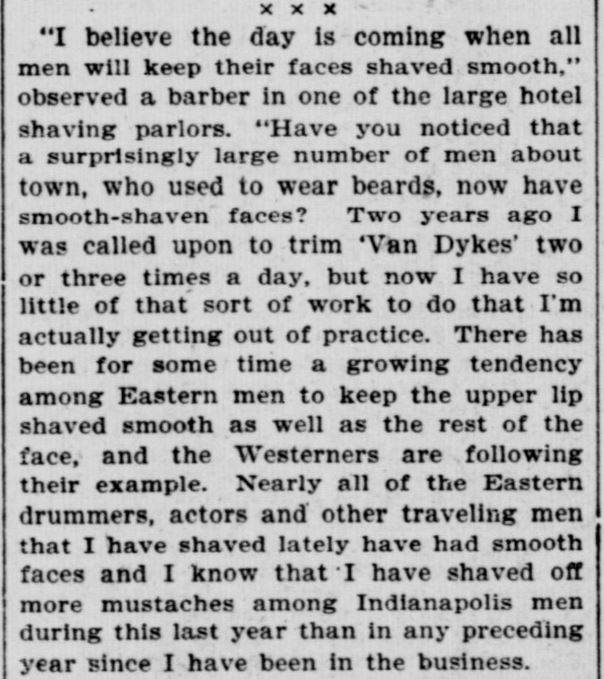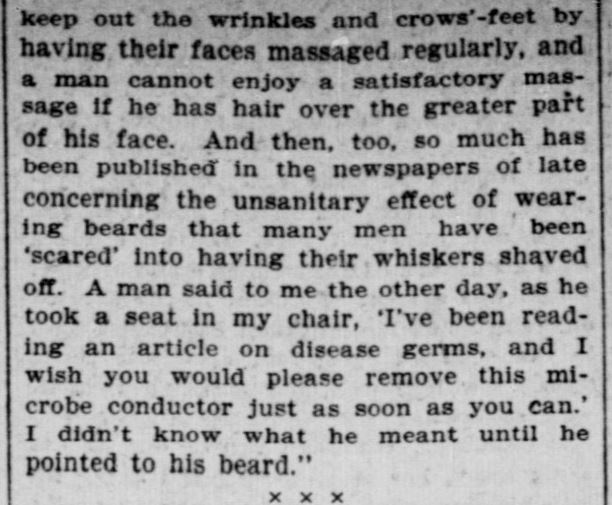 (The Greencastle Democrat, January 26, 1900.)
(The Greencastle Democrat, January 26, 1900.)
“Movember” or “No-Shave November” is a new tradition dating only back to 2003, when a group of Australians started growing “Mos” (Australian slang for “‘stache”) to raise awareness of men’s health issues, especially prostate cancer and depression. As many cancer patients lose their hair, some men this season are paying homage to the golden days when spectacular whiskers grew wild and free.
There’s more than a little five-o’clock foreshadowing, then, in that mustachioed dandy from 1900 pictured above. “Nervita pills” were one of many old-time panaceas that purported to relieve some of the more difficult masculine ailments, though this one, of course, wouldn’t cure one of the worst, cancer. Contrary to the cartoon version of history, the American public really did talk about sex-related issues back then — not necessarily on the front page, but certainly in the ads section, which was often full of treatments from doctors and drug store owners.
Since Hoosier State Chronicles often highlights episodes of American medical history, here’s our tribute to “No-Shave November.” We waded through a plethora of debonair mustachios and culled some worthy ones. Many yet remain for your discovery.
Amazingly, as an Indianapolis barber feared in November 1902, these bold bristles would soon enough go out of style. The Hoosier State’s own Benjamin Harrison was among the last generation of unshorn presidents. Since William Howard Taft in 1913, no president has sported facial hair, with the possible exception of Richard Nixon, whose disastrous five-o’clock shadow contributed to his loss to JFK in 1960. Even the boldest and most unconventional candidates in the coming election year don’t appear prepared to change this.
It was good business for the barber, at least.
(Indianapolis Journal, November 16, 1902.)
 (Indianapolis Recorder, January 15, 1910.)
(Indianapolis Recorder, January 15, 1910.)
 (The Greencastle Democrat, October 30, 1903.)
(The Greencastle Democrat, October 30, 1903.)
 (The Greencastle Democrat, January 16, 1897.)
(The Greencastle Democrat, January 16, 1897.)
 (Indianapolis Recorder, February 19, 1910.)
(Indianapolis Recorder, February 19, 1910.)
 (Indianapolis Recorder, July 30, 1910.)
(Indianapolis Recorder, July 30, 1910.)
 (Indianapolis Journal, July 7, 1891.)
(Indianapolis Journal, July 7, 1891.)
The following image from the cover of The Jewish Post (a national paper first printed in Indianapolis in 1933) isn’t Santa Claus, but a rabbi. The paper’s Rosh Hashanah or Jewish New Years’ edition came out in September 1939, just a few weeks into World War II.
(The Jewish Post, September 14, 1939.)
(Indianapolis Journal, May 3, 1892.)
(“A mix-up in bicycle polo,” Fort Wayne Daily News, August 29, 1896.)
Some native Hoosiers were known to sport impressive facial — or overgrowth, depending on your point of view. Lew Wallace, the Crawfordsville native who became colonel of the 11th Indiana Infantry (a Zouave regiment), Civil War general, territorial governor of New Mexico, author of the novel Ben Hur, and U.S. Minister to Turkey. Wallace’s Ben Hur came out on “this day in history,” November 12, 1880.
 (A younger Benjamin Harrison, Indiana’s only president.)
(A younger Benjamin Harrison, Indiana’s only president.)
Lawrenceburg’s James Henry “Jim” Lane became one of the most famous Jayhawk border fighters in Kansas during the run-up to the Civil War. A fiery abolitionist, Lane served as Lieutenant Governor of Indiana before he became a U.S. Senator from Kansas and a Civil War general. Wracked by depression, the famous wild and unkempt Hoosier Plainsman committed suicide in 1866 by shooting himself in the head while jumping out of a carriage.
 (Jim Lane, Hoosier native and Kansas “Jayhawk.”)
(Jim Lane, Hoosier native and Kansas “Jayhawk.”)
In 1852, Lane was part of the welcoming committee at the State House when one of the most famously hairy men of his time, Hungarian revolutionary Lajos Kossuth, paid a visit to Indianapolis. Kossuth — after whom a town in Washington County, Indiana, and a county in Iowa was named — had just escaped from Hungary via Turkey, been carried into exile on the USS Mississippi, and was touring the U.S., where crowds hailed him as a hero of democracy. Kossuth also inspired some Indianapolis men to become “hairy-faced bipeds.”
 (Lajos Kossuth, photographed in Washington, D.C., before he traveled west to Cincinnati, Indianapolis, and St. Louis in early 1852.)
(Lajos Kossuth, photographed in Washington, D.C., before he traveled west to Cincinnati, Indianapolis, and St. Louis in early 1852.)
(Madison Daily Banner, Madison, Indiana, March 3, 1852.)
One famous mustachioed American who often showed up in Indiana was the great boxing champion John L. Sullivan. Sullivan was from Boston but often came to the small-town Midwest for championship matches and general showmanship. He and his whiskers showed up in Logansport, Fort Wayne, and other towns in 1896.
Yet even the athletic Sullivan could have paid more attention to his own health. A heavy drinker for most of his life, the boxer later gave up the bottle and turned Prohibitionist Yet his overindulgence in food and booze led Sullivan to an early death at the age of just 59. It was said he died with “barely ten dollars in his pocket.”
 (John L. Sullivan, 1858-1918.)
(John L. Sullivan, 1858-1918.)
 (The Fort Wayne News, August 22, 1896.)
(The Fort Wayne News, August 22, 1896.)
Here’s another wild but lesser known visitor to the state. The famous shagginess of Polish pianist and composer Ignaz Jan Paderewski, “Wizard of the Keys,” was something that newspapers often noticed and editorialized.
In April 1902, Paderewski performed at Tomlinson Hall (above the “city catacombs”) in Indianapolis. This performer led a life as wild and varied as the direction of his hair. In addition to his global career as a concert artist, Paderewski later become a wine-grower in California and a politician who helped re-establish Polish independence after World War I. After Hitler’s invasion of Poland in 1940, he became the head of the Polish parliament exiled in London. Paderewski died in New York in 1941.
(Indianapolis Journal, April 6, 1902.)
 (Indianapolis News, November 6, 1900.)
(Indianapolis News, November 6, 1900.)
One last forgotten visitor worthy of note for his ‘stache was the spectacular Captain Jack Bonavita (real name John F. Gentner). The Indiana Tribüne announced Bonavita’s visit to “the Zoo” in 1901. This wasn’t the Indianapolis Zoo, but the old Zoo Theater, a vaudeville venue that once sat next to the Cyclorama across from the State House.
A famous animal trainer in New York and Hollywood, Captain Bonavita also worked with the silent film industry. Not long after this photo was taken, he was bitten by one of his trained lions in Indianapolis and spent some time at the City Hospital. He recovered from that bite in 1901. Tragically, in 1917, Bonavita was killed by a polar bear he was training.
(Indiana Tribüne, January 13, 1901.)
While ladies are often divided on the virtues of male facial hair. . .
 (Plymouth Tribune, March 5, 1903.)
(Plymouth Tribune, March 5, 1903.)
. . . if you’re sporting any extra growth this season, Hoosier State Chronicles invites you to take a bow.











